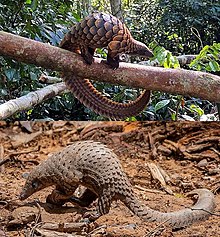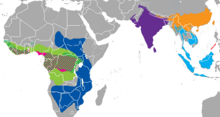Phataginus
Appearance
| African tree pangolin | |
|---|---|

| |
| Pangolins from genus Phataginus | |
| Scientific classification | |
| Domain: | Eukaryota |
| Kingdom: | Animalia |
| Phylum: | Chordata |
| Class: | Mammalia |
| Order: | Pholidota |
| Family: | Manidae |
| Subfamily: | Phatagininae Gaubert, 2017 |
| Genus: | Phataginus Rafinesque, 1821 |
| Species | |

| |
| Synonyms[2][3] | |
|
synonyms of subfamily:
synonyms of genus:
| |
African tree pangolin (Phataginus) is a genus of African pangolins from subfamily small African pangolins (Phatagininae), within family Manidae.[5] Its members are the more arboreal of the African pangolins.[6]
Etymology
Constantine Rafinesque (1821) formed the Neo-Latin generic name Phataginus from the French term phatagin, adopted by Count Buffon (1763) after the reported local name phatagin or phatagen used in the East Indies.
Taxonomy
- Subfamily: Phatagininae (small African pangolins)
- Genus: Phataginus (African tree pangolin)
- Phataginus tetradactyla (Long-tailed pangolin)
- Phataginus tricuspis (Tree pangolin)
- Genus: Phataginus (African tree pangolin)
Phylogeny
Phylogenetic position of genus Phataginus within family Manidae.[7][8][1]
| Pholidotamorpha |
| |||||||||||||||||||||
(Pholidota sensu lato)
|
References
- ^ a b Philippe Gaubert, Agostinho Antunes, Hao Meng, Lin Miao, Stéphane Peigné, Fabienne Justy, Flobert Njiokou, Sylvain Dufour, Emmanuel Danquah, Jayanthi Alahakoon, Erik Verheyen, William T Stanley, Stephen J O’Brien, Warren E Johnson, Shu-Jin Luo (2018) The Complete Phylogeny of Pangolins: Scaling Up Resources for the Molecular Tracing of the Most Trafficked Mammals on Earth
- ^ https://www.mv.helsinki.fi/home/mhaaramo/metazoa/deuterostoma/chordata/synapsida/eutheria/leptictida/manidae.html
- ^ https://www.pangolinsg.org/wp-content/uploads/sites/4/2016/06/Heath-1992-Manis-Pentadactyla.pdf
- ^ "Taxonomic Swap 25736". iNaturalist. 2017-10-08. Retrieved 2019-09-17.
{{cite web}}: CS1 maint: url-status (link) - ^ Schlitter, D.A. (2005). "Order Pholidota". In Wilson, D.E.; Reeder, D.M (eds.). Mammal Species of the World: A Taxonomic and Geographic Reference (3rd ed.). Johns Hopkins University Press. p. 531. ISBN 978-0-8018-8221-0. OCLC 62265494.
- ^ du Toit, Z.; du Plessis, M.; Dalton, D. L.; Jansen, R.; Paul Grobler, J.; Kotzé, A. (2017). "Mitochondrial genomes of African pangolins and insights into evolutionary patterns and phylogeny of the family Manidae". BMC Genomics. 18 (1): 746. doi:10.1186/s12864-017-4140-5. PMC 5609056. PMID 28934931.
- ^ Gaudin, Timothy (2009). "The Phylogeny of Living and Extinct Pangolins (Mammalia, Pholidota) and Associated Taxa: A Morphology Based Analysis" (PDF). Journal of Mammalian Evolution. 16 (4). Heidelberg, Germany: Springer Science+Business Media: 235–305. doi:10.1007/s10914-009-9119-9. S2CID 1773698.
- ^ Kondrashov, Peter; Agadjanian, Alexandre K. (2012). "A nearly complete skeleton of Ernanodon (Mammalia, Palaeanodonta) from Mongolia: morphofunctional analysis". Journal of Vertebrate Paleontology. 32 (5): 983–1001. doi:10.1080/02724634.2012.694319. ISSN 0272-4634. S2CID 86059673.
